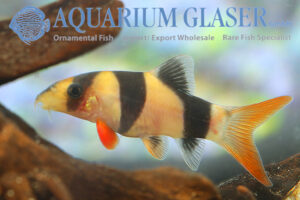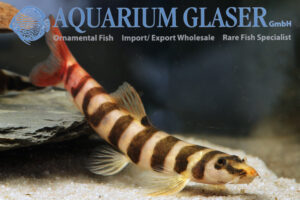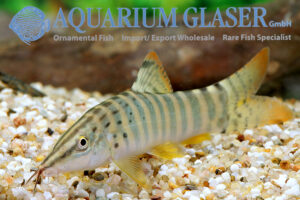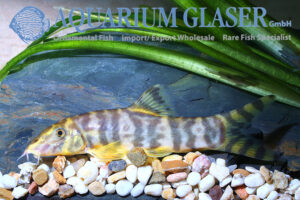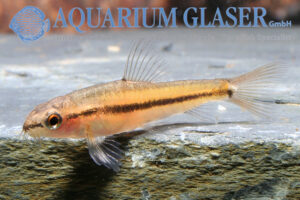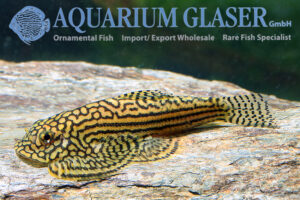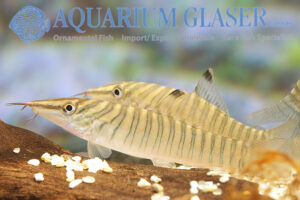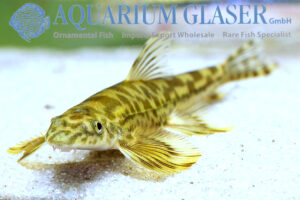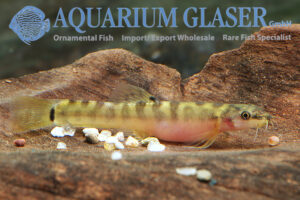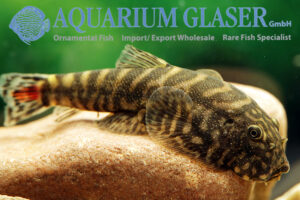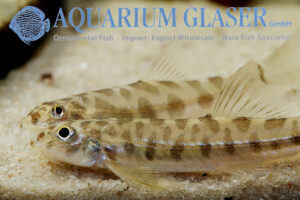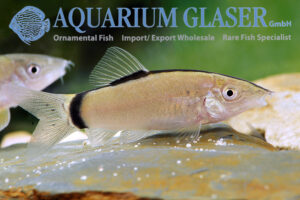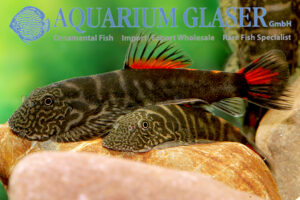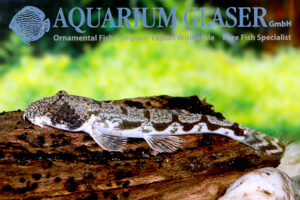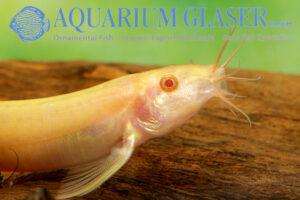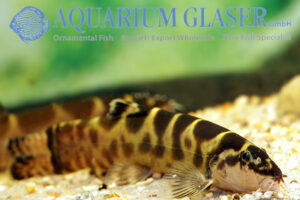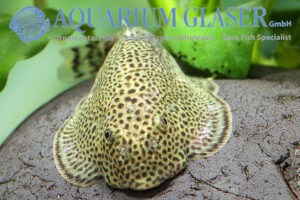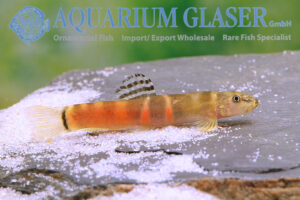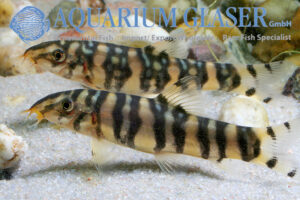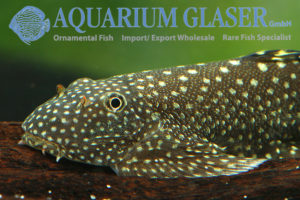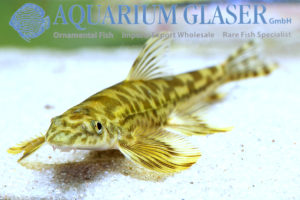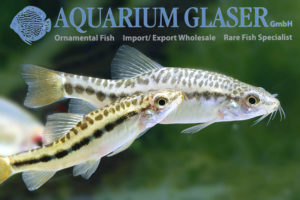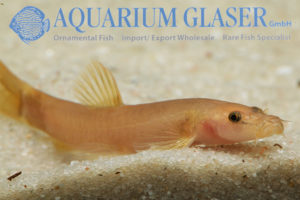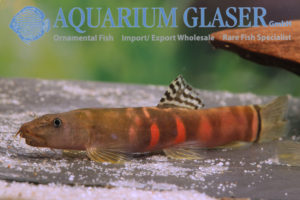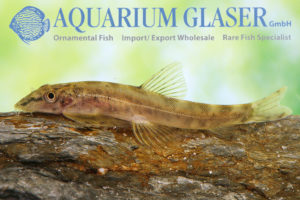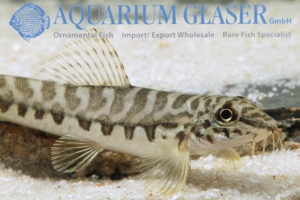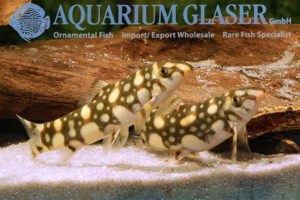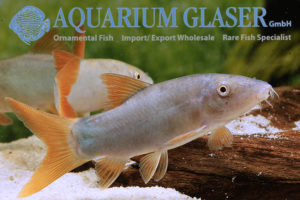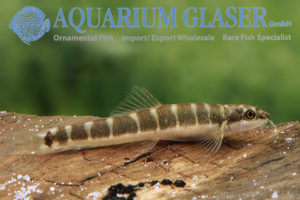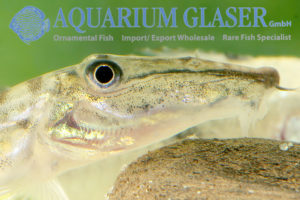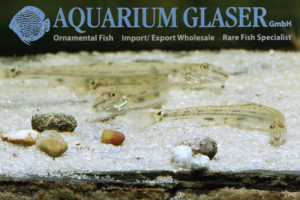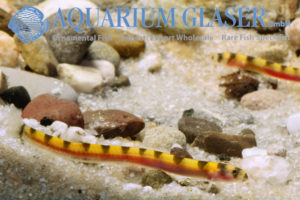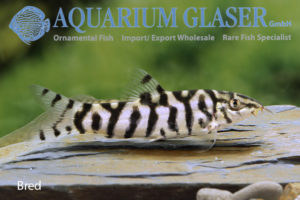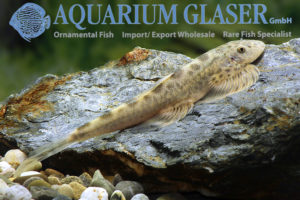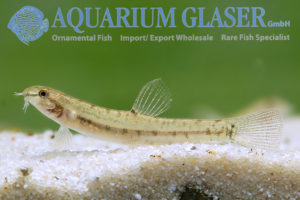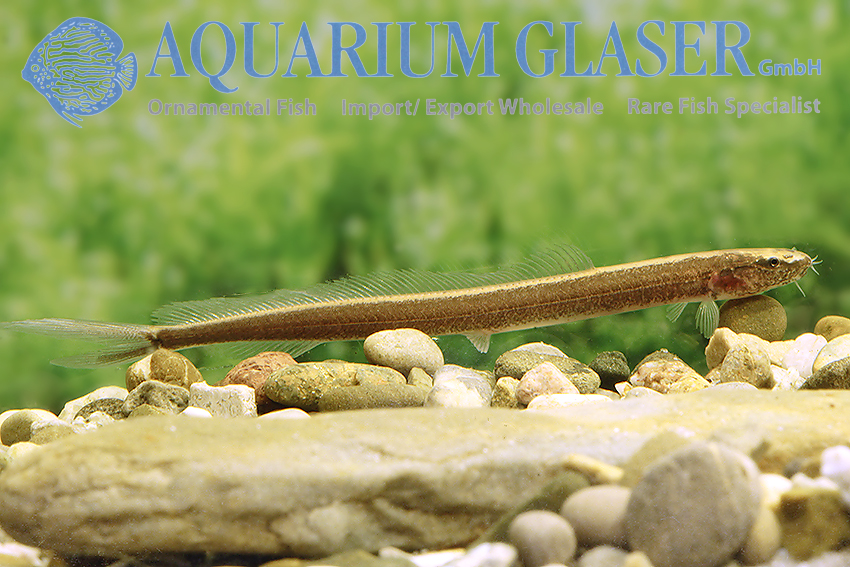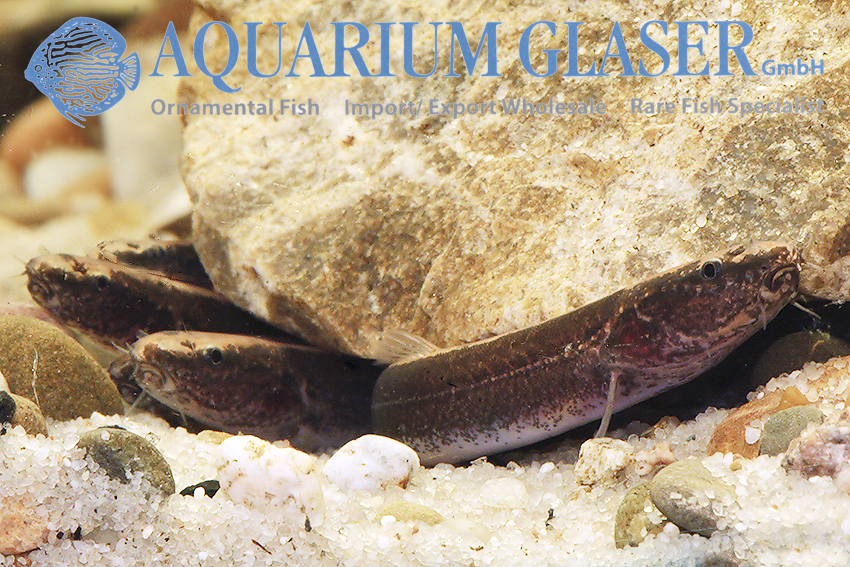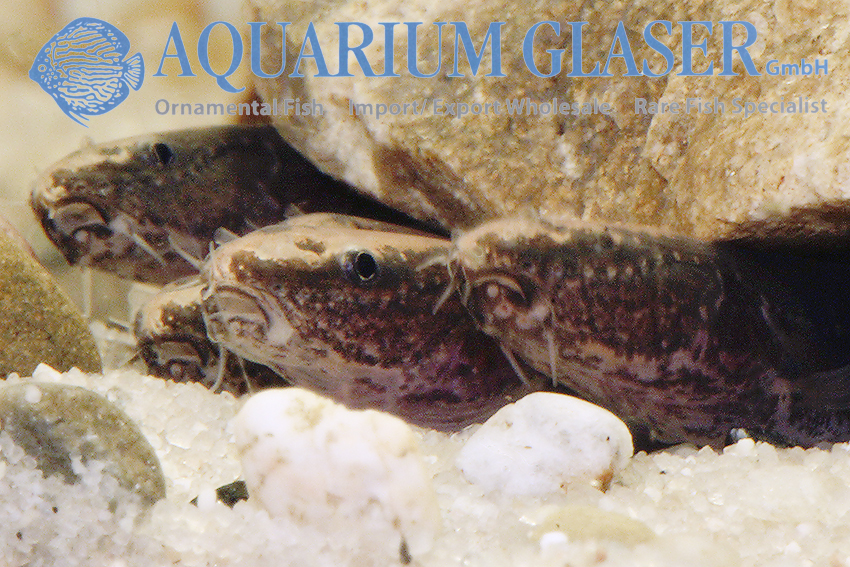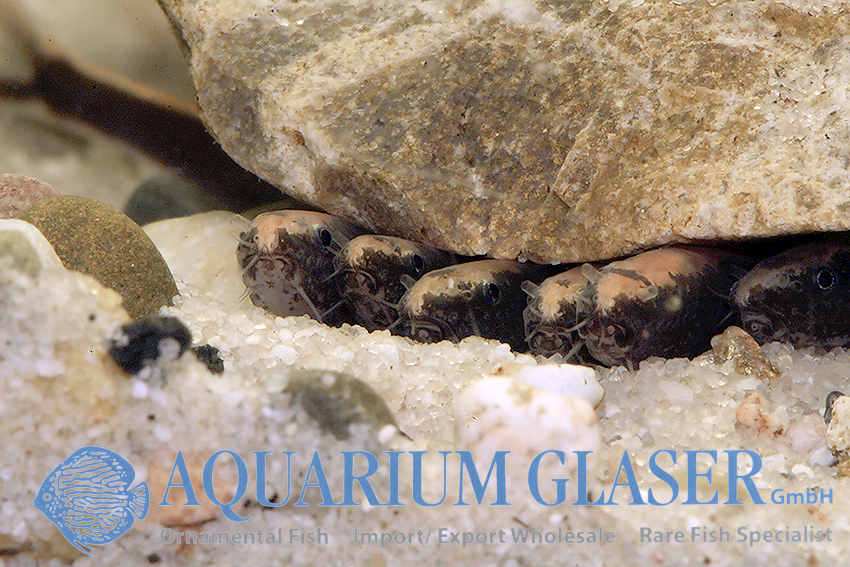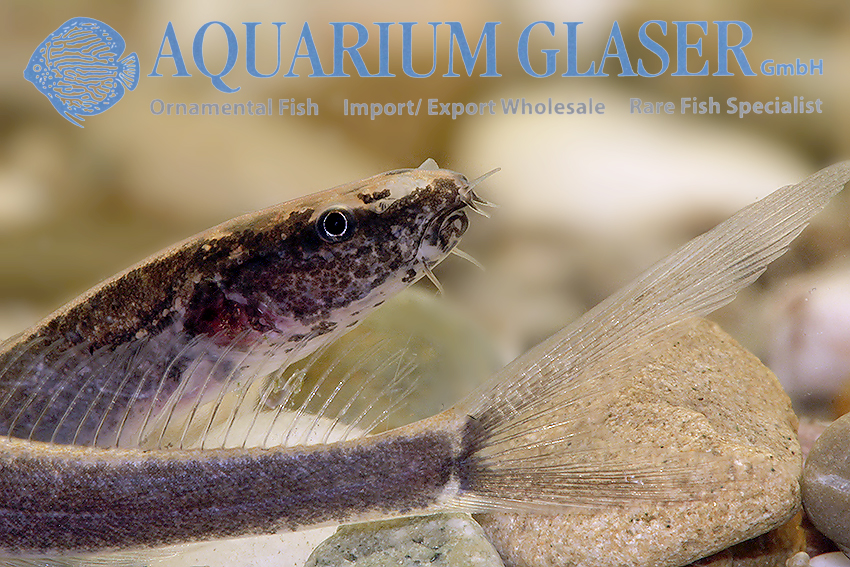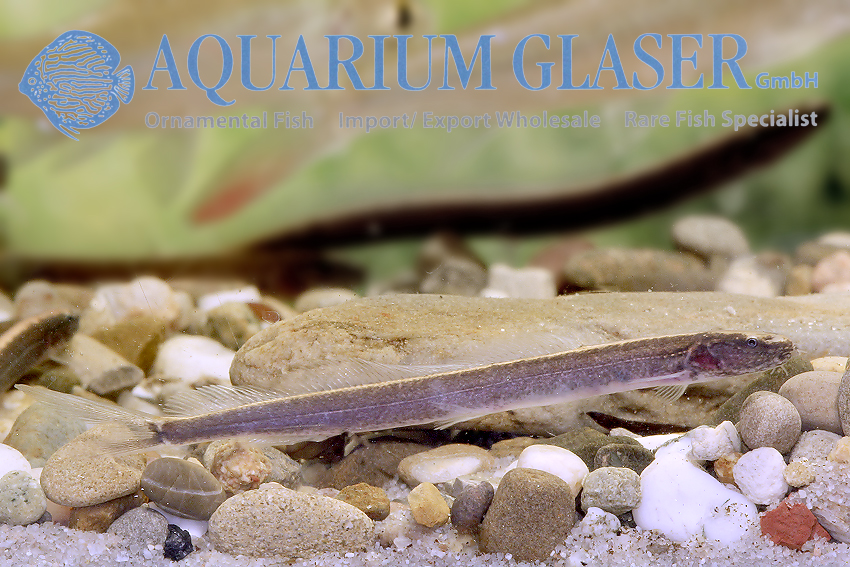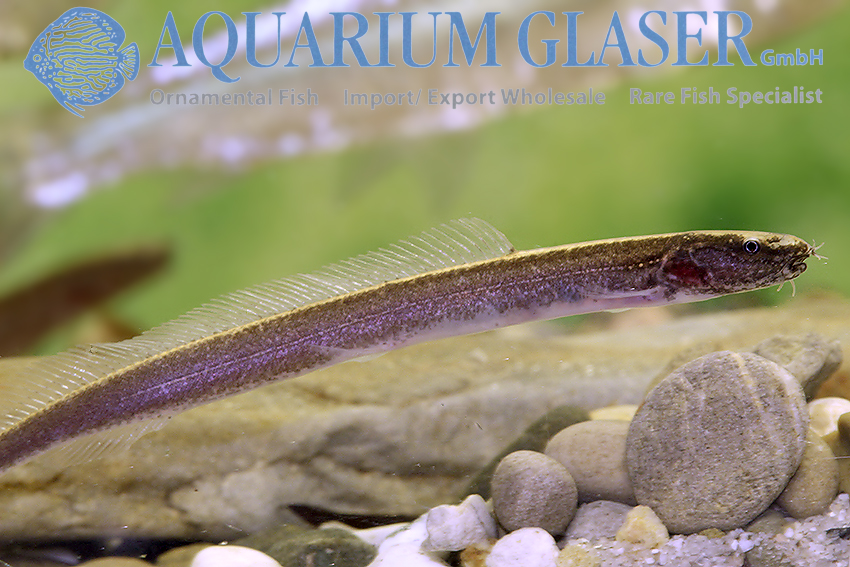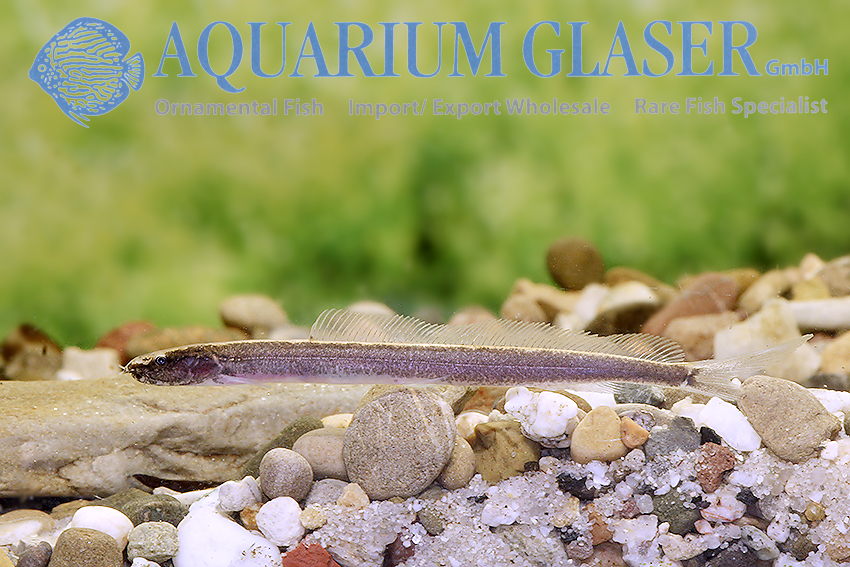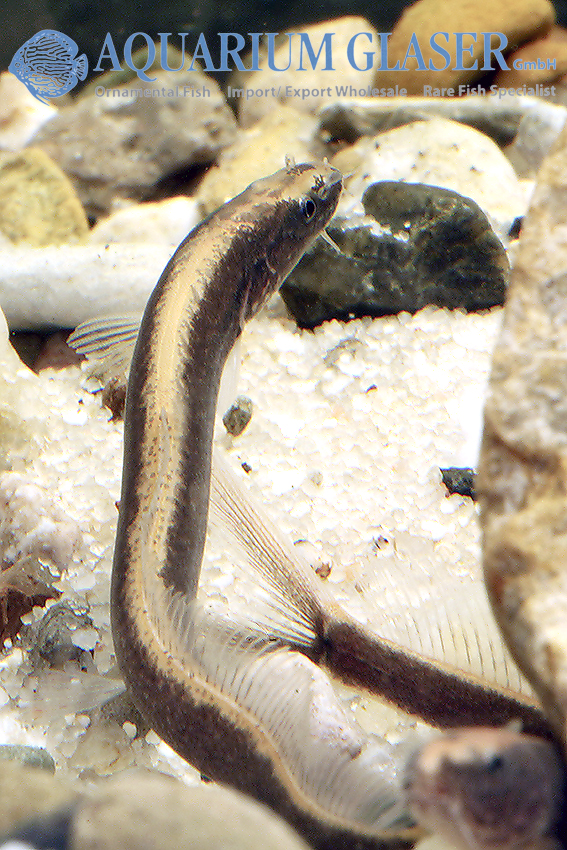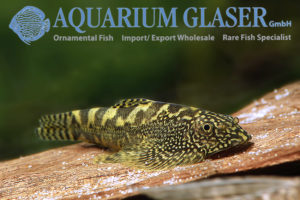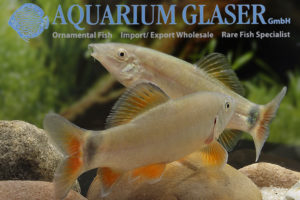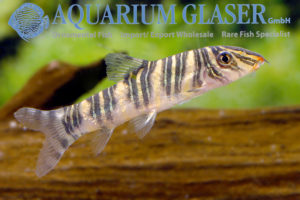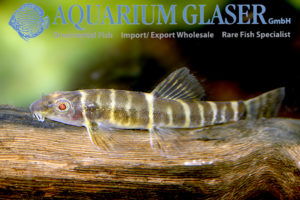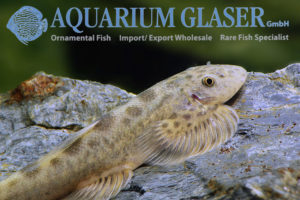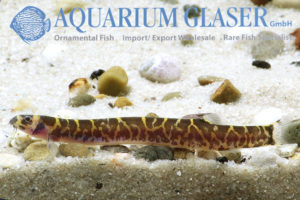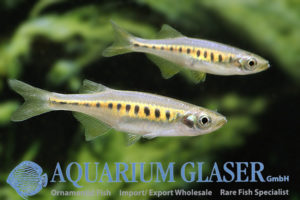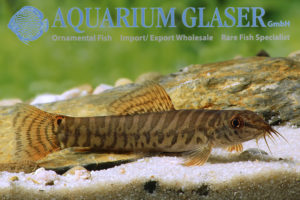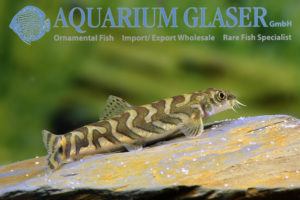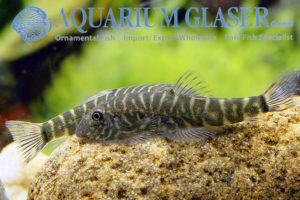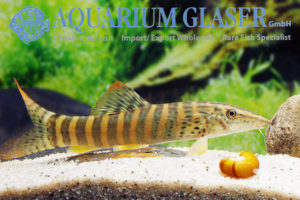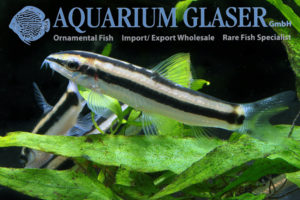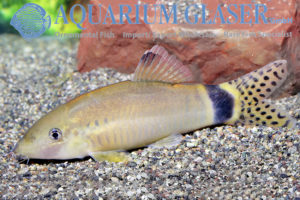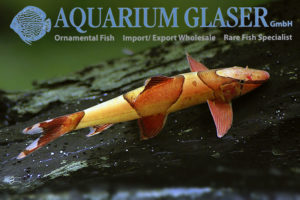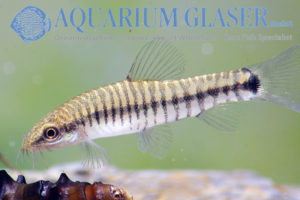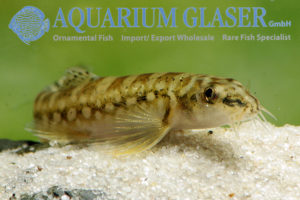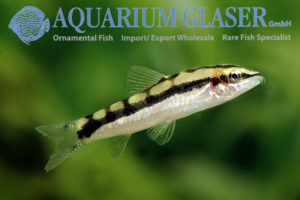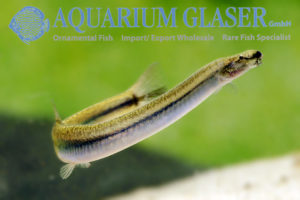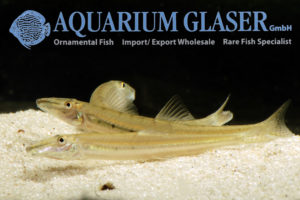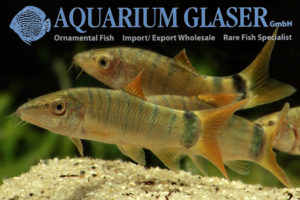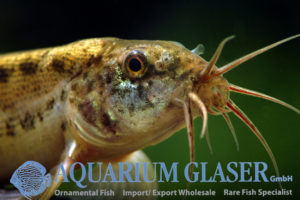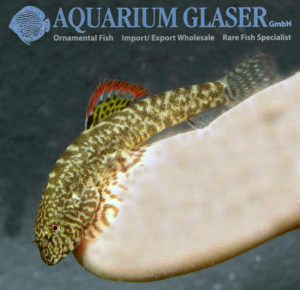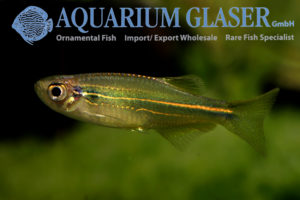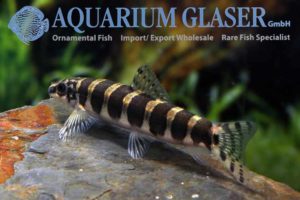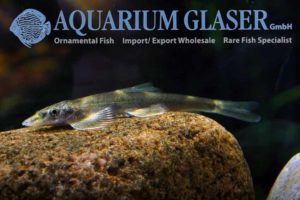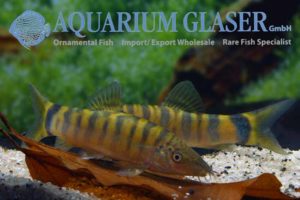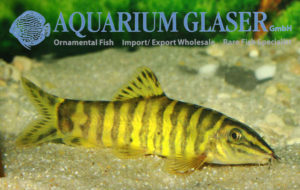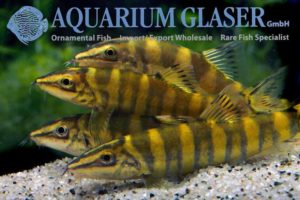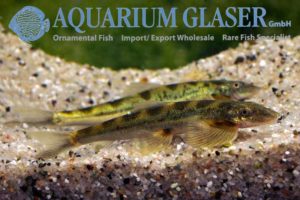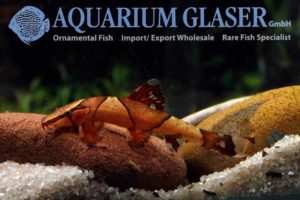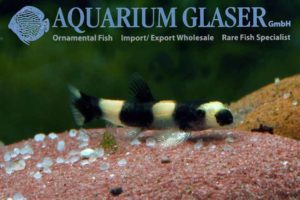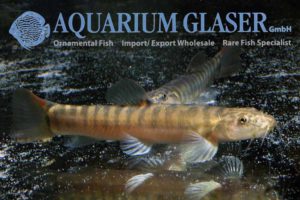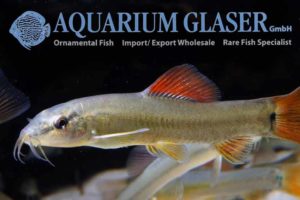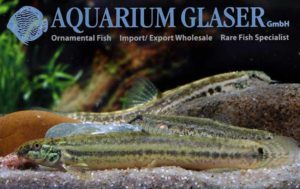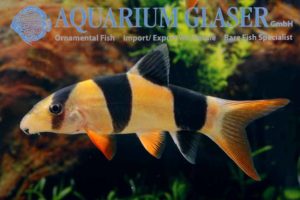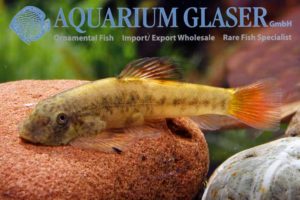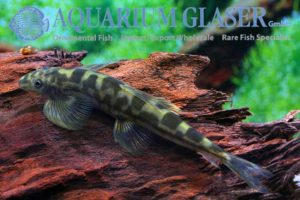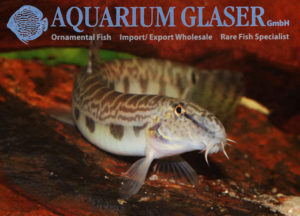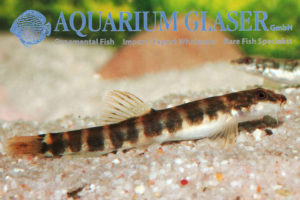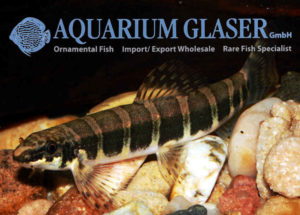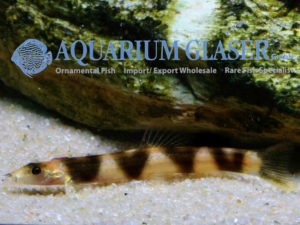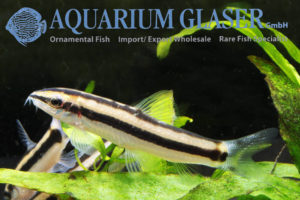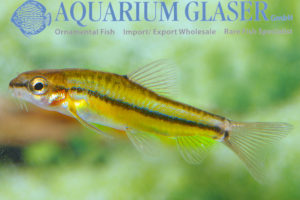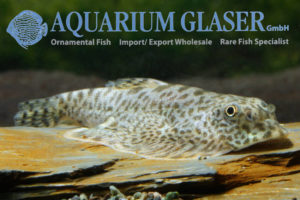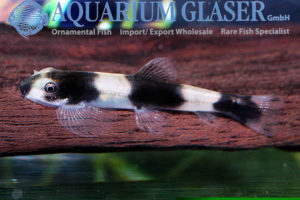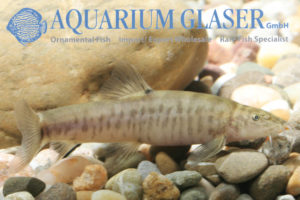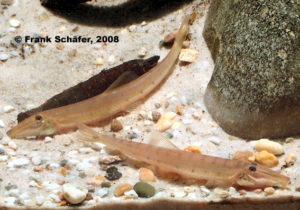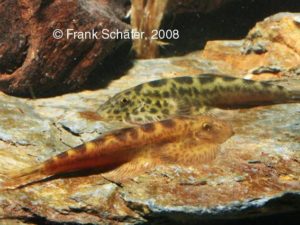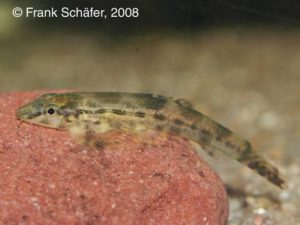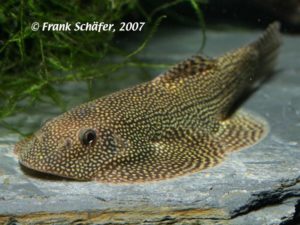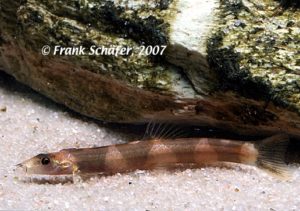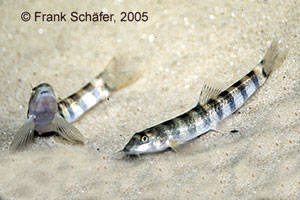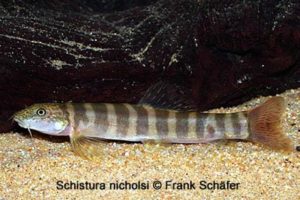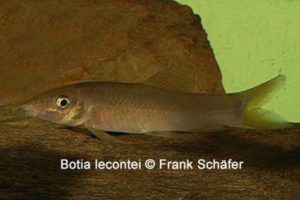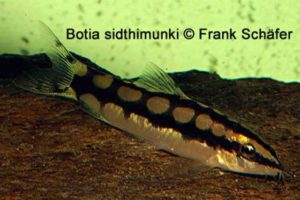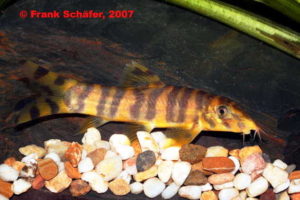There are only two species in the global ornamental fish trade that have been traded in large numbers for decades collected from the wild: the Cardinal tetra (Paracheirodon axelrodi) and the Clown loach (Chromobotia macracanthus). Due to the great economic importance of these animals, the populations are monitored very closely and there are strict laws […]
07. Carp like fishes (1): Loaches (100)
-
-
Kapuasia falaris
A new loach genus was only established in 2024, namely Kapuasia. The only species assigned to Kapuasia was K. maculiceps from the great Kapuas River on Borneo. Originally, K. maculiceps was assigned to the large collective genus Nemacheilus. As far as we know, K. maculiceps has not yet appeared aquaristically. Shortly after the genus Kapuasia […]
-
Syncrossus helodes (formerly: Botia helodes)
The tiger loaches (Syncrossus) were previously assigned to the genus Botia. There are currently 6 recognized species of these magnificent loaches, which are distinguished by their special pointed heads, but their identification is often uncertain and questionable, as species distinctions are usually based solely on colour characteristics. Unfortunately, these color characteristics are not always constant […]
-
Botia udomritthiruji
From time to time you have to tidy up the homepage a bit. On one such occasion we came across this nice post from 2007: Botia sp. New Emperor, probably imported for the first time, comes from the border region of Burma/Thailand. It is said to occur there in large numbers every ten years and […]
-
Physoschistura mango ( = Yunnanilus sp. Rosy)
A delightful dwarf loach from Burma has been enriching the aquarium hobby since 2006. It was called Yunnanilus sp. Rosy before its scientific description in November 2023. The scientific analysis showed that the characteristics of the species (especially the lip structure, but also DNA examinations) do not allow it to be assigned to Yunnanilus and […]
-
Sewellia lineolata
From a zoological perspective, hillstream loaches belong to the family Gastromyzontidae and are very close relatives of the brook loaches, which belong to the family Balitoridae. Hillstream loaches are adapted to life in flowing water. Their pelvic and pectoral fins are enlarged and look like the spoilers of a car. The water flowing over the […]
-
Syncrossus hymenophysa ( = Botia h.)
There are six to seven species of tiger loaches (Syncrossus), their identification is sometimes tricky and occasionally difficult even for specialists: S. beauforti (Southeast Asia from the northern Malay Peninsula to China (Yunnan) and Vietnam), S. berdmorei (Burma and India), S. formosus (controversial form, possibly synonymous with S. lucasbahi, lower Mekong: Thailand, Laos, Cambodia and […]
-
Annamia sp. (= Vanmanenia sp.) Vietnam
From time to time we receive the beautiful, large hillstream loaches Annamia normani (see https://www.aquariumglaser.de/en/fish-archives/annamia_normani_en/) from Vietnam. Recently we received again a shipment of very similar specimens, but they differ clearly from the A. normani we know well by the very contrasting tail fin. Since all specimens (over 50) show this feature, it cannot be […]
-
Schistura notostigma
With one of our first Sri Lanka imports of wild-caught fish after a long time, we also received Schistura notostigma. Until recently this species was thought to be the only Schistura species from the island, but recently two other species have been described from there, S. madhavai and S. scripta. The easiest way to distinguish […]
-
Gastromyzon sp. SK2 Red Tail
Recently we were able to introduce you to the new Gastromyzon “Bloody Mary” (one of our readers recommended calling it “Lamandau” after the collecting area): https://www.aquariumglaser.de/en/fisharchive/gastromyzon-sp-bloody-mary-2/ As mentioned in the above post, we have received further species, a “Red Tail” and a “Bluel”. The “Red Tail” has been known in the hillstream loach community for […]
-
Nemacheilus corica
Amongst the many species* of loach (mainly the genera Nemacheilus and Schistura, but there are more genera) that exist in India, one in particular has proven itself as an aquarium fish: Nemacheilus corica. There are many reasons for this: it remains small (5-6 cm), is peaceful, looks nice, eats all common ornamental fish foods, is […]
-
Yasuhikotakia morleti
What the armored catfish (Corydoras & Co.) are in a South American tank, the clown loaches (Botia & Co.) are in an Asian tank: interesting, beautiful and lively bottom fish. However, much more species knowledge is required for Botia than for armored catfish to avoid unpleasant surprises. Some species, such as the popular true clown […]
-
Gastromyzon sp. “Bloody Mary”
The hillstream loaches of the genus Gastromyzon have developed an enormous diversity of species on the island of Borneo. The ichthyologist Tan first analyzed this diversity in 2006 and described no less than 15 new species in his book “The Borneo Suckers”. Since then, a total of 36 species of the genus have been known […]
-
Canthophrys gongota ( = Somileptus gongota)
The moose faced loach from India is a very unusual representative of its family. Although there are many loach species that burrow, Canthophrys gongota has perfected this behavior. In its natural habitat, the rivers in the north of Bengal, it lives where the bottom is made up of fine sand. Here it likes to bury […]
-
Misgurnus anguillicaudatus GOLD
The albino breeding form of a weather loach (Misgurnus) originating from subtropical Asia is currently enjoying a constant increase in popularity. We call it Misgurnus anguillicaudatus, but this is only a makeshift name, as the correct species names of the Asian Misgurnus species cannot currently be determined. The albino weather loach reaches a length of […]
-
Leptobotia tchangi
The loaches of the genus Leptobotia differ from all other botiide loaches in that the razor-sharp, sickle-shaped spine under the eye, which all botiide loaches can erect and lock in the event of a perceived or real threat, is only single-pointed. In Botia & Co. it is usually two-pointed. At present, around 20 species are […]
-
Beaufortia kweichowensis
The name for this hillstream loach may be new to you, but you know the animal. In fact, Beaufortia kweichowensis is or was the most common hillstream loach in the trade and was traded as “China Pleco”, “Chinese Butterfly Sucker” or “Butterfly loach”, with the scientific name usually being Beaufortia leveretti. Beaufortia leveretti really does […]
-
Schistura atarensis ( = Schistura cf. balteata)
There are a large number – over 300, of which over 200 are considered valid species – of scientifically described Schistura species; only very few of these have found their way into aquaria to date. One of the most beautiful is the species previously known as Schistura cf. balteata from Thailand, which was recently (October […]
-
Botia rostrata
To say it right away: nobody knows exactly which species of loach is hidden behind the name Botia rostrata from a scientific point of view. But this is not the right place to discuss such things. Especially interested people are referred to the very detailed work of Steven Grant (2007). The loach we present here […]
-
Gastromyzon “punctulatus”
In 1961, a review paper on the hillstream loaches of the genus Gastromyzon of Borneo was published. In it five species were distinguished: G. pauciradiatus, G. nieuwenhuisii, G. fasciatus, G. punctulatus and G. borneensis. In 2006 the next revision of these fishes from Borneo appeared. This was accompanied by a true species explosion; in Gastromyzon […]
-
Annamia sp. (= Vanmanenia sp.) Vietnam
From time to time we receive the beautiful, large hillstream loaches Annamia normani (see https://www.aquariumglaser.de/en/fish-archives/annamia_normani_en/) from Vietnam. Recently we received again a shipment of very similar specimens, but they differ clearly from the A. normani we know well by the very contrasting tail fin. Since all specimens (over 50) show this feature, it cannot be […]
-
Petruichthys brevis (formerly: Yunnanilus brevis)
Petruichthys brevis is a species of loach that originates from Burma. Here it occurs only in Inle Lake. The species attains a length of only 4-5 cm and thus belongs to the small species of fish. In contrast to most other species of loach, this one is a free swimming, schooling species. The swimming behaviour […]
-
Schistura cf. quasimodo
A funny name for a funny loach! In 2000, Kottelat assigned it to a loach from Laos when describing it scientifically. Quasimodo was the hunchbacked bell-ringer in a world-famous novel by Victor Hugo. And the loach from Laos has a hump – hence the name. However, the loach from Laos has a second characteristic that […]
-
Schistura cf. balteata
There is a very great number of scientifically described species of Schistura – more than 300. About 200 of them are currently considered as valid. Only very few species have been imported so far as aquarium fishes. One of the most spectacular of them Schistura cf. balteata, a species collected in the region of Ranchaburi. […]
-
Bhavania australis
Along the west coast of India runs a mountain range known as the Western Ghats. There is a hotspot of biodiversity. An unusually large number of species of freshwater fish are endemic there, i.e. only found there and nowhere else in the world. These include the two species of the genus Bhavania, namely B. annandalei […]
-
Paracanthocobitis botia
From India we could import again this pretty loach. With its 5-7 cm final length it is an ideal bottom fish for moderately tempered (16-22°C) community aquariums with fish of this region, like zebra danios (Danio rerio), rosy barbs (Pethia conchonius), dwarf gourami (Colisa lalia) etc.. In nature, all these species are also occasionally found […]
-
Botia kubotai
Some botias, among them B. kubotai, are available only seasonal and for a quite short time per year. The very beautiful species B. kubotai originates from the Salween-tributary Ataran in the border region between Burma and Thailand. It becomes around 8-10 cm long, maximum length reported so far is 13 cm. This species is one […]
-
Yasuhikotakia modesta (2)
One of the most beautiful and largest botias besides the well known and popular Chromobotia macracanthus is the Redtail botia Yasuhikotakia (formerly: Botia) modesta from Southeast Asia. These are gorgeous fish, usually with a very unusual dove blue base coloration that contrasts very nicely with the red fins. But there are also green, yellow-finned variants […]
-
Schistura savona
What the Corydoras are in South America, the Schistura loaches are in Asia. In hundreds of species they populate practically every stream and smaller river of the tropical and subtropical regions of the continent. In many cases, identification is difficult or impossible. Not so with Schistura savona from India. Its “half band” pattern with white […]
-
Acantopsis dialuzona
In the last years we received horseface loaches (Acantopsis) mainly from Thailand, where the genus is represented by several species, which are difficult to distinguish. Now we have once again received specimens from Indonesia. It is A. dialuzona, the best known species of the genus by name. In older aquarium books this species can be […]
-
Acanthopsoides robertsi
Horseface loaches (Acantopsis) are popular and well-known aquarium fishes, but with 15-20 cm attainable final length (the record is even 25 cm) they become quite large and therefore need larger aquariums. Practically unknown to aquarists are the dwarf horseface loaches (Acanthopsoides), whose seven species grow to only 3.5-5.5 cm in length. The photographed specimens are […]
-
Pangio cuneovirgata
Usually the different species of banded Coolie loaches (Pangio kuhlii, P. semicincta, P. myersi, P. shelfordi, P. alternans, P. cuneovirgata, P. malayana) are not distinguished in the trade because they are so variable in color and are often imported mixed. The sorting of Coolie loach is an activity you don’t want your worst enemy to […]
-
Botia lohachata
The systematics of the Indian deep bodied loaches – they represent the remaining species in the formerly much broader genus Botia – is confused. Botia lohachata was described from Bihar in India as early as 1912. Their coloration is very specific: three Y-shaped bands – the first in front, the second below and the third […]
-
Hemimyzon nanensis
With the import of Hemimyzon nanensis we were once again able to fill a white spot on the map of fishes that have become known in the aquarium with content. At least for us it is a first import. Hemimyzon belongs to the family of hillstream loaches (Balitoridae) and is closely related to the genus […]
-
Lepidocephalichthys kranos
For the first time we can offer these cute dwarf spined loach from Vietnam. They become (without caudal fin) at most 3,5 cm long. Lepidocephalichthys kranos was not recognized as an independent species until 2010. The species differences in Lepidocephalichthys are very subtle (otherwise they would have been scientifically identified earlier), but it is quite […]
-
Sewellia “breviventralis”
From Vietnam we have once again been able to import beautiful hillstream loaches of the genus Sewellia under the name Sewellia breviventralis. The species S. breviventralis exists and it is anatomically very similar to the imported animals, but there are differences in colouring compared to the live imported animals, whose exact origin is unknown, but […]
-
Yasuhikotakia (formerly: Botia) eos
This beautiful and interesting loach, which can attain a maximum length of about 12 cm, originates from Thailand. This type of loach is said to be sometimes very aggressive. Y. eos is considered as one of the most aggressive species of all. However, in most cases this is a mistake of the keeper. Y. eos […]
-
Botia striata
Currently we have very nice zebra loaches, Botia striata, in stock. The animals have an ideal size, 3-4 cm. The maximum length the species can reach is about 6-8 cm. In many species of loach the generic name has changed in the past years. The Clown loach, formerly known as Botia macracanthus, is now Chromobotia […]
-
Barbucca diabolica
Currently we managed once more to import one of the cutest loaches from Borneo. Barbucca diabolica is despite its terrifying name a totally peaceful animal. Sadly almost nothing is known about the species. In nature, it lives in small forest streams in the Kapuas system on Borneo. Our animals have already almost the size of […]
-
Hemimyzon nanensis
With the import of Hemimyzon nanensis we were once again able to fill a white spot on the map of fishes that have become known in the aquarium with content. At least for us it is a first import. Hemimyzon belongs to the family of hillstream loaches (Balitoridae) and is closely related to the genus […]
-
Pangio alternans
Kuhlii loaches (Pangio) are very popular aquarium fish. They are cute, small and often colourful. In community aquariums the small water snakes act as a cleaning crew, which reliably prevents food residues from being left lying around. The animals are completely peaceful and love the company of conspecifics. Kuhlii loaches become restless before thunderstorms and […]
-
Inlecypris auropurpureus
The Inle Lake in Burma has a high proportion of endemic fish species, i.e. fish that occur exclusively there. One of them is Inlecypris auropurpureus, a Danio with vertical stripes on a golden band. The number and shape of the stripes are slightly different for each individual. Inlecypris is closely related to the species placed […]
-
Paracanthocobitis rubidipinnis
This beautiful loach comes from Burma, where it is found in the Irrawaddy system. They are exceptionally lively animals that are constantly in action with each other. For this reason, it is not acceptable to combine fish that love peace with Paracanthocobitis rubidipinnis. The animals – they become about 6-7 cm long – are however […]
-
Mesonoemacheilus triangularis
The loaches of Asia are an enormously species-rich fish group. Similar to the cory catfish in South America, a great part of the species has not yet been scientifically described. A well recognizable species is the Zodiak Loach, Mesonoemacheilus triangularis, from South India; here it occurs endemically in the Western Ghats. The genus Mesonoemacheilus differs […]
-
Gastromyzon viriosus
We were able to import this charming zebra hillstream loach from Indonesia. The determination of the numerous species of Gastromyzon from Borneo (more than 30 different species are known from the island) is quite tricky, many species look quite similar to each other. So we cannot exclude the possibility that our fish will proof to […]
-
Syncrossus berdmorei
The tiger loaches (Syncrossus) are a genus of comparatively large (about 15 cm), beautiful loaches. Formerly they have been added to the genus Botia. Currently five species are distinguished, among them Syncrossus berdmorei. Sadly this species is offered only occasionally, because it belongs to the most colorful species of the genus. The natural distribution of […]
-
Ambastaia nigrolineata: It doesn´t have to be always sidthimunki….
These dwarfish relatives of the clown loach have done a kind of odyssey in respect of the generic name in the past. Both were originally described in the genus Botia. Later they were placed in Yasuhikotakia. Only in 2012 they changed to the genus Ambastaia, which has been generated especially for them. This genus contains […]
-
Yasuhikotakia splendida
The genus Yasuhikotakia was separated from the genus Botia by Teodor Nalbant in 2002 and currently comprises 10 species. Some of them are important aquarium fish like Y. morleti (older synonym: Botia horae) and Y. modesta. The newest species on the ornamental fish market is Y. splendida, which was described as Botia splendida in 1995. […]
-
Homaloptera parclitella
Hillstream loaches belong to the family of loaches. Probably the most beautiful species can be found in the genus Homaloptera. There are several closely related and similar looking species. In the German one calls it often “saddle-stain-loaches”, English, the animals become “lizard loaches” called. Homaloptera parclitella is an extraordinarily beautiful hillstream loach from the black […]
-
Micronemacheilus cruciatus (= Yunnanilus c.)
This charming free swimming dwarf loach originates from Vietnam. It attains a maximum length of about 3.5 cm. For quite a long time it was placed in the genus Yunnanilus, but currently mot scientists see them in the monotypical (this means the genus contains only one species) genus Micronemacheilus. These fish are totally peaceful and […]
-
Mesonoemacheilus guentheri
There are ten known species in the genus Mesonoemacheilus. They are small, 4-6 cm long, very lively loaches. All of them occur along the Western Ghats, a mountain chain along the west coast of India, the so called Malabar coast. These mountains border the inland against the Arabian Sea. The Western Ghats are a so […]
-
Ambastaia sidthimunki
From northern Thailand originates the dwarfish Checkerboard Loach formerly known as Botia sidthimunki, then as Yasuhikotakia s. As it is a rather small (6 cm) and very peaceful species, it represents an ideal member for an asiatic community tank. There it can be kept together e.g. with small representatives of the genera Danio, Rasbora and […]
-
Pangio anguillaris
The Kuhli loaches (Pangio, formerly Acanthophthalmus) form an important part of all smaller community tanks with a southeast Asian character. Here the small „watersnakeletts“ are cleaning and feed all the small food particles that might have been overlooked by the other fish. Of course the loaches have to be fed also; this is no problem […]
-
Acantopsis rungthipae
You don´t know that name? We didn´t either, until some days ago a taxonomical revision of the horseface loaches of the genus Acantopsis was published. All loaches of the genus used to be named Acantopsis dialuzona in the trade (sometimes the synonym A. choirorhynchos was also used). Currently seven different species are considered to be […]
-
Yasuhikotakia modesta
We received from Thailand this wonderful sport of the Blue Loach (Yasuhikotakia modesta, formerly known as Botia modesta). The species is well known for its variability. Most often the fish are blue with bright red fins, but the body colour can vary from blue over green to blue-grey and the fins can be anything from […]
-
Misgurnus anguillicaudatus
We received beautiful weather loaches via Hongkong. The genus is characterized by the existence of ten barbels around the mouth. The funny name „weather loach“ was given in medieval times, when these loaches were kept in captivity as weather prophets. These fish breath not only via gills but have an additional breathing technique. When the […]
-
Pseudogastromyzon cheni
Now the season for the charming hillstream loaches imported via Hongkong has started. There do exist several species and we also have several species in stock currently. There is a lot of confusion regarding the identity of two species of Pseudogastromyzon, namely P. cheni and P. myersi. Both species look almost identical. And both species […]
-
Danio sp. Hikari Blue & Yellow
Hikari-Danios belong to a scientifically still undescribed species of Danio from Burma. The closest relative is Danio kerri. However, Hikari danios are by far more colorful than D. kerri and really beautiful fish. Keeping and breeding Hikari Danios is absolutely comparable to the very well known zebra fish, Danio rerio. Hikari danios attain a maximum […]
-
Serpenticobitis cingulata
We received this beautiful loach from Thailand. The genus Serpenticobitis contains only three species, all of which were described in 1997/98. They differ mainly in their coloration: in S. octozona (the type species, comes from Laos and Cambodia) the light spaces between the dark bands are very narrow, in S. zonata (Laos) much wider. Whereas […]
-
Pseudohomaloptera sp – A new dwarfish hillstream loach from Vietnam
For the first time ever we obtained this hillstream loach from Vietnam. The determination is pretty tricky. All features visible in live fish (position of the dorsal fin, coloration, position of the anus) lead to the genus Pseudohomaloptera, which currently includes six described species: Pseudohomaloptera tatereganii (Popta 1905), P. sexmaculata (Fowler 1934), P. leonardi (Hora […]
-
Yasuhikotakia sp New Cambodian Tiger
Formerly all the deep bodies loaches from Indochina were placed in the catch-all genus Botia. This generic name should be used now only for the Indian species, while the species from Laos, Thailand, Cambodia, and Vietnam are placed in Ambastia, Syncrossus, and Yasuhikotakia. We now were able to import for the first time ever a […]
-
Sinibotia robusta
We received beautiful coloured Kansu loaches (Sinibotia robusta) from China. This comparatively peaceful species is best kept at room temperature (18-24°C) without an additional heater. Only very few specimens available! For our customers: the fish have code 405053 on our stocklist. Please note that we exclusively supply the wholesale trade. Text & photo: Frank Schäfer
-
Sinibotia robusta
Every year in June is import season for Botia-like loaches from China. The genus Sinibotia currently contains six species. The genus Sinibotia differs from Botia by the presence of three pairs of barbel (two maxillary, one mandibulary), while in Botia a fourth pair of barbels is present on the lower lip. Sinibotia robusta is also […]
-
Homaloptera cf. leonardi Vietnam
We were able to import once more hillstream loaches from Vietnam. Instead of the expected Annamia normai (see http://www.aquariumglaser.de/en/fish-archive/loaches-en/Annamia_normani_en/) we received another species. The determination is a very tricky thing. The most coincidences are to the species Homaloptera leonardi. Especially the scale-less zone between pectoral and ventral fins is said to be very typical for […]
-
Homaloptera parclitella
Hillstream loaches are – in general – rather dull coloured fishes. However, there are exceptions and among the most beautiful species are those belonging to the genus Homaloptera. Several, closely related and quite similar species exist. In German they are called “saddle-back loaches”, a commonly used English name is “lizard loaches”. For the first time […]
-
Protomyzon pachychilus – season for Panda loaches!
The extremely charming juveniles of the Panda loach are available only a few weeks per year. Obviously this year was a good one for the fish and they have bred very successful, because a comparatively large number of specimens is offered for comparatively low prices. Among the good number of specimens we were able to […]
-
Schistura spilota
The loaches of the genus Schistura are spread all over South and Southeast Asia. They have much in common with the catfishes of the genus Corydoras from South America: they are present everywhere and there does exist a large number of species. Schistura spilota from Thailand is one of the largest species at all and […]
-
Traccatichthys taeniatus
For the first time ever we could import this pretty, red-finned loach from Vietnam, which has the popular name “Peppermint Loach” due to the bright green shine on the flanks. The species attains a length of about 12 cm and is very peaceful. One should keep these fish always in groups, for they are very […]
-
Lepidocephalichthys guntea – the ideal aquarium loach
There is hardly a second species of loach that is as good suited for the home aquarium as Lepidocephalichthys guntea is. The species becomes usually 6-8 cm long, only in very rare occasions larger specimens up to 15 cm have been reported in literature. The animal has a huge distribution area over the north of […]
-
Chromobotia macracanthus
The clown loach is one of the most popular species of loach at all. One should keep this up to 20-30 cm long species always in a small school, for clown loaches are very social animals. Text & photos: Frank Schäfer
-
Pseudogastromyzon sp. Red Fin
Hillstream loaches have become more and more popular in the past years and some of the smaller species are imported on a regular basis now. Currently we received a new species via Hongkong. The very pretty fish attains a length of 4.5 – 5 cm. The males are already mature, they can be recognizes by […]
-
Annamia normani
This top-rarity among the hillstream loaches reached us from Vietnam, where the genus Annamia is represented by this single species. A second, formally described species (A. thuathiensis), also from Vietnam, needs to be researched. A. normani has also been reported from Laos and Cambodia. Annamia normani attains a maximum length of about 10 cm and […]
-
Cobitis macrostigma
We received this beautiful and absolutely peaceful loach from China. The species is an ideal bottom dweller for unheated community tanks. The optimal temperatures for the fish are between 10 and 24°C. Females become around 10 cm long, while males stay much smaller. The fish, which could be named “Largespotted Spiny Loach”, feeds readily on […]
-
Physoschistura cf. elongata
For the first time ever we can offer this charming dwarf loach from the North of India. Maximum length of the species is only 4.5 cm. The fish is undemanding and completely peaceful. For our customers: the animal has code 454882 on our stocklist. Please note that we exclusively supply the wholesale trade. Lexicon: Pysoschistura: […]
-
Serpenticobitis octozona
Currently we have extraodinary wonderful, adult, 4-6 cm long loches of that species, which is also traded under the name of “medusa loach”, in stock. For our customers: the fish have code 455012 on our stocklist. Please note that we exclusively supply the wholesale trade. Lexicon: Serpenticobitis: means “snake-Cobitis”; Cobitis is another genus of loach. […]
-
Schistura pridii
We received very nice specimens of this nano-loach from Thailand – maximum length reported for the species is only 4.5 cm. Available in limited numbers only! For our customers: the fish have code 454982 on our stocklist. Please note that we exclusively supply the wholesale trade. Text & photos: Frank Schäfer
-
Yasuhikotakia nigrolineata
This pretty loach is distributed in Laos, Thailand and parts of China. Obviously it is a close relative of the dwarf chain loach, Y. sidthimunki, and the behaviour of Y. nigrolineata is absolutely the same. However, there are two distinguishing features – besides the coloration: first, Y. nigrolineata become a bit larger, about 8 cm […]
-
Yunnanilus sp.
The genus Yunnanilus comprises a comparably high number of species: 30 species are currently recognized as valid, but there are for sure much more species. Most known species have a very small distribution area. If you realize that only a very small part of the waters in the area of the genus have ever been […]
-
Sewellia speciosa
Currently we were able to import this nice hillstream loach from Laos for the first time. The species is restricted to the Kong river influence in Laos and Vietnam. Maximum length is around 6 cm. The species has a very interesting sexual dimorphism. Males – which are in general more tiny than females – develope […]
-
Protomyzon pachychilus
For the first time we were able to import these charming hillstream loaches. Due to their origin (China) and their black&white coloration we call them dwarf panda hillstream loaches. Although the species has been scientifically described back in 1980 in a Chinese journal almost nothing has been published concerning the beautiful animal since then. Our […]
-
Schistura cf. jarutanini
The brook loaches of the genus Schistura are far spread over South and Southeast Asia. There are hundreds of species, most of them still scientifically undescribed. Almost each flowing water has it´s own species. So it is no surprise that some of the species also became cave-dwellers. We could import a small number of individuals […]
-
Acantopsis sp.
(Nov.6th 2008)Due to its unusual head shape the horseface loach A. coirorhynchos is one of the most popular aquarium fish. In nature they often are residents of clear rivers, where you can find them especially on sandy grounds. Inside the aquarium you also have to provide sandy ground, which allows them to completely bury themselves. […]
-
Sinogastromyzon wui
(18. Feb.2008) Last week we received this loach which was described by FANG 1930. Their habitat is from the Nanpan-jiang and Xi-jiang basins in Guangdong to Guanxi provinces in China. The maximum size is about 8-10cm. They should be kept in cold water, not over 22-23°C, and they have very high oxygen requirements. To offer […]
-
Homaloptera tweediei
(14.Feb.2008) The adult size of the gecko-loach, Homaloptera tweediei, is only approx. 4cm. This species is very interesting for the hobbyists, because they can be kept for a longer period in a water temperature of more than 24°C. The main reason is the origin in central Thailand. After acclimatisation they are very thankful and easy […]
-
Sewellia sp. Spotted
(19.Dec.2007) This, very attractive, probably scientifically not described hillstream sucker reached us from Vietnam. They remember on Sewellia lineolata but their point pattern is finer and also is the for S. lineolata characteristic “stripe” missing. Like all hillstream suckers they come from fast flowing water, there they inhabit rapid flowing streams where they graze on […]
-
Schistura pridii
(19.Oct.2007) Last week we received another new item: Schistura pridii. This beautiful small loach (grows up to 4.5cm) comes from Thailand. Exactly they were found in the upper Chao Praya Bassin in the Chiangmai province in the north of Thailand. They come from cool (18-24°C) & fast floating rivers, containing hard and alkaline water, which […]
-
Schistura beavani (wrong determined: S. scaturigina)
This loach belonging to the family of River loaches (Baltoridae) originates from Darjeeling and Assam in the eastern Himalayan mountains, Northern India, Nepal and Bhutan, where it lives in fast streaming rivers. This is a peaceful species, which is suitable for a well-kept aquarium. This loach should be nurtured in a well filtered and aerated […]
-
Schistura nicholsi
To an unusually large about 200 species comprehending genus belongs Schistura nicholsi the Redtail Zebra Sand Loach. It originates from the Mekong basin in Thailand and Laos, where it inhabits fast flowing waters on a stony ground. This is to be considered during its aquarium maintenance. In order to ensure a high oxygen content and […]
-
Yasuhikotakia lecontei
From the watershed of the Mekong originates this circa 15 cm long getting loach. The name red finned loach is something misleading, since not all animals show this colouring in all stages of age. During their development they change colours and pattern. Young animals usually exhibit a pattern of stripes which disappears during ageing. In […]
-
Yasuhikotakia sidthimunki
From northern Thailand originates the Dwarf Loach formerly known as Botia sidthimunki. Since it is a rather small (6 cm) and very peaceful species, it represents an ideal member for an asiatic community tank. There it can be kept together e.g. with small representatives of the genera Danio, Rasbora and Microrasbora . One should always […]
-
Botia sp. „New Emperor“
The ever first import of Botia sp. “New Emperor”, probably comes from the borderland of Burma/Thailand. It should appear in a decadal yearly rhythm in a large amount and can only be caught then. An area informed ichthyologist stated that transportation through bordering hilly regions can only be helped by small mopeds, where a slight […]
-
Chromobotia macracanthus
In our picture you see an interesting mutant of the clown loach, which reached us these days. Although Chromobotia macracanthus formerly known as Botia macracantha is a long time tank inhabitant, it is still not without mysteries. This applies particularly to the breed, so far we have only coincidence success. Also in the maintenance they […]
Vaillantella maassi
This is certainly one of the most peculiar loaches ever. The genus Vaillantella – at present three species are distinguished – has a band-shaped dorsal fin running over the entire back, while all other loaches have relatively short, triangular dorsal fins.
Vaillantella are black-water-inhabitants and become 12-15 cm long, usually remain however clearly smaller; V. maassi is widespread in the peat-swamp-areas of Malaysia and Borneo, a habitat extremely endangered through destruction for oil palm plantations. Unfortunately, therefore all fish (and other living beings), that occur there, must be classified as highly endangered. The catch of ornamental fish can help to preserve at least parts of these biotopes as economic areas and is therefore an active environmental and species protection.
Vaillantella maassi has so far only very rarely been kept in aquariums. One should care for it analogous to the well known Kuhli loaches (Pangio). The very large, forked tail fin enables Vaillantella an explosive propulsion; the aquarium must be covered therefore absolutely gaplessly, so that the animals do not land on dry land, if they are grabbed by the well-known wandering instinct, which many loaches show temporarily in the aquarium.
For our customers: the animals have code 473053 on our stocklist. Please note that we exclusively supply the wholesale trade.
Text & photos: Frank Schäfer
New Tiger Loaches from Indonesia

The
Tiger Loaches (Syncrossus) have been placed in Botia formerly. The
members of Syncrossus have a very sharp head. Currently 6 species are
recognized, two of them from Indonesia, namely Syncrossus hymenophysa
and S. reversus. Both can be easily told apart, for B. hymenophysa has
dark tiger stripes on a light ground, B. reversus light tiger stripes on
a dark ground.

Now
we obtained Syncrossus from Indonesia that cannot be safely applied to
one of the two species mentioned, although they are definitively closer
to S. hymenophysa than to S. reversus. But the fish remind one much more
to the also undetermined species of Syncrossus that appeared some years
ago in the market and said to come from Laos.

While
the stripes on the flanks of the new Syncrossus from Indonesia vary a
lot in number, the coloration of the fins is very uniform in all
specimens observed. Most probably the new Tiger Loach will reach a
maximum length of 15-20 cm as reported in the other Tiger Loaches. All
Syncrossus are known to be quite aggressive fish. They should be kept in
large aquaria with a lot of hiding places and in groups. At least five
specimens are needed, otherwise the fish cannot develop their quite
complex social behaviour.



For
our customers: the fish have code 401001 (3-4 cm) and 401102 (4-6 cm)
on our stocklist. Please note that we exclusively supply the wholesale
trade.
Text & photos: Frank Schäfer
It doesn´t have to be always sidthimunki….

These
dwarfish relatives of the clown loach have done a kind of odyssey in
respect of the generic name in the past. Both were originally described
in the genus Botia. Later they were placed in Yasuhikotakia. Only in
2012 they changed to the genus Ambastaia, which has been generated
especially for them. This genus contains only two species, namely
Ambastaia nigrolineata and A. sidthimunki. The genus is defined by the
unique coloration of these species.


Ambastaia
nigrolineata occurs in Laos, Thailand, and China. However, like A.
sidthimunki almost exclusively bred specimens are offered nowadays,
because otherwise only a very seasonal availability would be given. A.
nigrolineata stays almost as small as A. sidthimunki and becomes around
7-8 cm long (including tail fin).

Juveniles
have only two black stripes on an ebony white body, later the males
develope a pattern that is quite similar to that of A. sidthimunki.
For our customers: the fish have code 404702 on our stocklist. Please note that we exclusively supply the wholesale trade.
Text & photos: Frank Schäfer
A new ornate hillstream loach

The
genus Sewellia has made the hillstream loach popular in the hobby. The
splendid Sewellia lineolata is named also orante hillstream loach.
However, there are more beautiful species in the genus which are
imported now and then. Sadly it is often not possible to determine them
exactly. We were able to import one of the latter species now.

In any case this ornate hillstream loach is a real enrichment for the aquarium hobby!

For our customers: the fish have code 455044 on our stocklist. Please note that we exclusively supply the wholesale trade.

Text & photos: Frank Schäfer
Large Emperor Loaches arrived!

For
the first time we obtained Emperor Loaches (Leptobotia elongata) of a
size of 14-18 cm. However, this is not the maximum length reported for
that wonderful species! It is said to reach 50 cm and 3 kg in weight!
Sadly the gorgeous species is highly endangered in the wild. It is known
only from the upper and middle Yangtse River. Of course the species is
not endangered due to the collecting for the ornamental fish trade, but
due destruction of the natural habitat. Luckily it is possible to breed
this loach in captivity. The Emperor Loach should be winterhardy even in
garden ponds in Central Europe.




For our customers: the fish have code 400404 on our stocklist. Please note that we exclusively supply the wholesale trade.

Text & photos: Frank Schäfer
Hillstream loach week at Aquarium Glaser! Part 4: Chinese Rarities

Vanmanenia pingchowensis
Only three specimens of this attractive species were imported recently. The fish are about 8 cm long and seem to be almost fully grown. The species is found in mountain strams, where they live on the bottom between pebbles.
 Erromyzon sinensis
Erromyzon sinensis
This is a small species, reaching hardly 5 cm. It is interesting that they differ much in coloration. Some specimens are almost uniform brown while others have a pattern of fine stripes. The species is restricted to the West River.
 Sinogastromyzon wui
Sinogastromyzon wui
This is the only hillstream loach of today´s update that we have more or less regulary in stock. They are very pretty and reach around 6 cm in total length. The species is found on the island of Hainan and in the Zhujiang River on the Chinese mainland. Golden (xanthotistic) specimens occur regularly. Normally the basic colour of the fish is a warm brown.

Text & Photos: Frank Schäfer
Hillstream loach week at Aquarium Glaser! Part 3: Crossostoma lacustre, Homaloptera tweedei, Gastromyzon punctulatus
 Crossostoma lacustre
Crossostoma lacustre
Crossostoma lacustre is a species that we were able to import for the very first time now. It is endemic on Taiwan. That means it occurs nowhere else in the World. Despite its scientific name (lacustre means: „Living in a lake“) it is found in nature only in heavily torrent waters of small brooks. The maximum size reported for that species is 12 cm.
 Homaloptera tweedei
Homaloptera tweedei
Homaloptera tweedei is a chraming dwarf species that reaches only 4-5 cm in length. Although it is not that much colorful it is a real eyecatcher due to its funny behaviour. In nature – we get this species from Thailand – it lives in medium sized streams where it swims over on large stone plates and stuff like that.
 Gastromyzon punctulatus (G. ctenocephalus?)
Gastromyzon punctulatus (G. ctenocephalus?)
The island of Bormeo is home to a very large number of hillstream loaches. Sadly it is virtually imposible to give a correct name on them, although a great revision of these fishes was published quite recently (2006). But there are many species which are known already but which are not yet described formally and thus it is impossible to identify them. So in the trade we use the catch-all name Gastromyzon punctulatus for this group of species, as it was also usually in the scientific literature until 2006.
Leaving the difficulties in naming the species aside these spotted hillstream loaches are wonderful aquarium inhabitants. As they come from tropical areas they can be kept in heated tanks. The species we actually have in stock has very nice blue fin membranes, but sadly they show them only for a very short time. The fish become 6-7 cm long. Their body coloration varies between light brown and deep black. Scattered over this ground coloration are yellow spots of different size. Currently our species is often identified as G. ctenocephalus.
 Gastromyzon punctulatus (G. ctenocephalus?)
Gastromyzon punctulatus (G. ctenocephalus?)
For our customers: Crossostoma lacustre has the code 412692, Homaloptera tweedei 421632 and Gastromyzon punctulatus 416562. Please note that we exclusively supply the wholesale market.
Text & photos: Frank Schäfer
Hillstream loach week at Aquarium Glaser! Part 2: Beaufortia leveretti

This is by far the most often offered hillstream loach. It originates from China and Vietnam, but is currently imported from China only. The whole habitus is very similar to the Sewellia species we presented yesterday. The coloration is formed by pretty black spots on golden underground.
The most important fact one has to know about B. leveretti is that this is not a tropical fish at all, but comes from moderate climate zones. Thus it is impossible to keep it in a long time sight at water temperatures above 24°C. The ideal range is 12°C in winter and 21°C in summer. Avoid abrupt jumps in temperature!
B. leveretti is therefore an ideal inhabitant of unheatet aquaria and helps you to save energy costs. A perfect tankmate for B. leveretti is the White cloud mountain minnow, Tanichthys albonubes. A school of that fish containing about 15-20 specimens in the water column and 10-12 Beaufortia form a very nice picture.
Text & photo: Frank Schäfer





